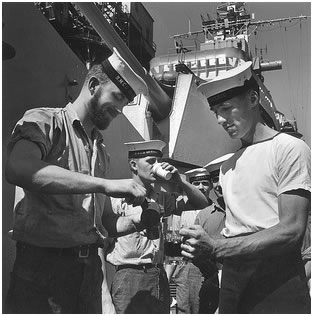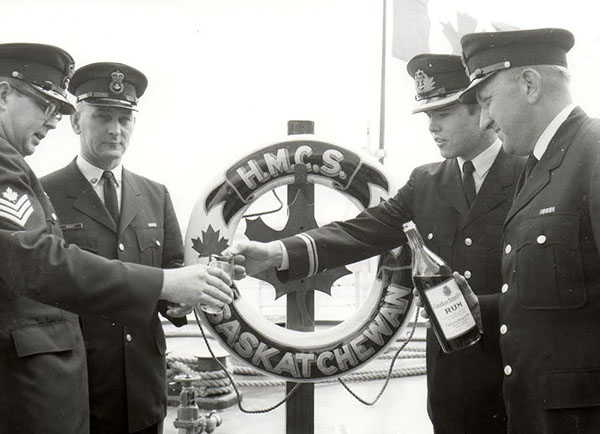Customs and Traditions
The History of the Tot
Prior to the 24th of March 1743, The Royal Navy issued beer, wine and spirits in place of tea, coffee and cocoa and even water on all shifts.
On the 16th of January 1745, beer and spirits were issued on alternative days. In 1831 all issues except rum were ceased.
1824 saw the issue reduced from half a pint to two and a half ounces as a "TOT" of neat rum. In 1850 the issue was reduced to once a day at NOON.
The formation of the Royal Canadian Navy in 1910 carried over many of the Royal Navy traditions and the daily issue of a "TOT" being one that was continued until the 30th of March 1972.
Canada was the last Commonwealth Navy to cease this tradition.
"UP SPIRITS"
 "UP SPIRITS" was the age old call for men of the Royal Navy and, after 1910, in ships of the Royal Canadian Navy to muster for their daily issue of rum.
"UP SPIRITS" was the age old call for men of the Royal Navy and, after 1910, in ships of the Royal Canadian Navy to muster for their daily issue of rum.
Played on the Bosn's call, this to men of the Navy was the most welcomed and merriest of the three dozen odd orders that could be relayed via the Bosn's pipe.
The last time this particular call was heard at 6 bells in the forenoon watch of the ships of the R.N. was July 31, 1970, and March 31, 1972 in Canadian ships... bringing to an end a tradition over 300 years old in British ships and 62 years old in Canadian ships.
The decision was not exactly accepted gracefully on the lower deck and in the Chiefs and P.O.'s Messes - and this day of infamy became known as "Black Tot Day".
But the decision to do away with the daily tot was not made lightly by their lordships in Whitehall and came about only after several years of deliberation - with one of the more serious possibilities under consideration being that of mutiny - such beingthe hallowed place that the daily rum issue enjoyed in the hearts of Navy sailors.
Regardless, in 1972, Canada's Navy Authorities decided that a hefty tot of rum at midday was not the best of medicine for men entrusted to handle the floating electronic complexes that Naval ships had become.
In the R.N. the announcement in this regard was made by Admiral Sir Andrew Le Fanu... a diminutive, red-headed officer who henceforth became known derisively to the lower deck as "Dry Ginger".

Photo: 30 March 1972 in HMCS SASKATCHEWAN. Ceremonial issue of last tot to PO2 Christie, CPO1 Pegley and PO1 Ryan by Slt May. (DND Photo submitted by Cameron May)
GROG
 This was not the first occasion on which a decision in regard to the prized rum issue had been met with lower deck derision - and was the direct reason for rum becoming known as "GROG". Because grog was an Admiral before it was an acoholic beverage, "Old Grog" being the knickname of the eccentric, garrulous and somewhat blue-nosed Admiral Edward Vernon, R.N. who derived his name from the peculiar boat clock made of a coarse material called grogam he wore while pacing the decks of his flagship.
This was not the first occasion on which a decision in regard to the prized rum issue had been met with lower deck derision - and was the direct reason for rum becoming known as "GROG". Because grog was an Admiral before it was an acoholic beverage, "Old Grog" being the knickname of the eccentric, garrulous and somewhat blue-nosed Admiral Edward Vernon, R.N. who derived his name from the peculiar boat clock made of a coarse material called grogam he wore while pacing the decks of his flagship.
The hero of Porto Bello, a Spanish stronghold in Panama which Vernon captured in 1739 with a Squadron of just six ships, had long been a foe of rum, or rumbullion as it was then known... or the Dagon Drunkeness, as Vernon termed it... Dagon being a Philistine God... half man and half fish... appropriate! Vernon was appalled at what he felt were the debilitating effects which the daily issue of 1/2 pint per day of neat 80 proof rum, plus a gallon of beer if they desired it, had on all hands. Particularly in the tropics. Here in his order to Captains of the W.I. Squadron of which he was in command he wrote:
"It gave rise to brutal disregard to their duty as Christians and their being thoughtlessly hurry'd into all sorts of crimes and you are hereby required and directed to consult with your surgeon and to make me a return in writing severally under your own hand and his how you thik so growing an evil may be most effectually remedy'd.
And you will take into your consideration whether their spirituous liquor being mixed in some due proportion of water daily when it is issued to them, or any part of it being abated for a proportion of sugar being mixed with it for making it more palatable, may not be in some sort of a remedy to it, and will give your opinions with that care and consideration as the spiritual and temporal welfare of your fellow subjects as well as his Majesty's Service may require of you. Given etc..."
Vernon's Captains took their cue from their Commander and expressed themselves accordingly as they obviously had instructed their surgeons to do. Thus, within 17 days of his first order, came another order to the Captains:
"You are therefore hereby required and directed, to take particular care that rum be no more served in soecie to any of the ship's company under your command, but that the respective daily allowance of half a pint a man for all your officers and ship's company, be every day mixed with the proportion of a quart of water to every half pint of rum, to be mixed in a scuttled butt kept for that purpose, and to be done upon deck, and in the presence of the Lieutenant of the watch, who is to take particular care to see that the men are not defrauded in having their full allowance of rum. Given this day... etc"
But to the sailors of this Squadron, Old Grog was either a hero or a blue-nosed cheat, depending on whether a man liked his rum neat or diluted with water. An unknown member of the crew of HMS BERWICK, a ship in the Old Grog's Squadron, marked his own views on this matter in verse:
A mightly bowl on the deck he drew and filled it to the brink;
Such drank the Berwick's gallant crew and such the Gods shall drink;
The sacred robe which Vernon wore was drenched within the same;
And hence its virtues guard our shore and Grog derives its name.
Thus, while many sailors were predictably peeved by Old Grog's directives re rum, he himself felt justifiably pleased, as he notes in a letter to a friend:
My last order of the 21st of August for driving that Dagon Drunkeness out of the fleet, has, I thank God likewise; Had a very good effect, and, through God's mercy on us I am glad to acquaint you we shall go to sea a tolerably healthy Squadron for a West India one."
But something that begs the question of whether Old Grog's efforts to develop a more sober lifestyle on the lower deck was indeed the only motivating factor, relate to the harsh punishments inflicted for drunkeness at seain those days. The FIRST OFFENCE called for 24 strokes of the cat; the second offence, 48 strokes; and, eventually, the usually fatal punishment of KEEL-HAULING. Fortunately for the Canadian Navy, flogging was abolished in 1881.
Something we should note ion the foregoing is that, while Admiral Vernon was the cause for watered rum becoming known as Grog, another term which was to become a lower deck buzzword also originated with his standing order that Grog be mixed in a scuttled butt - with "ScuttleButt" becoming a lower deck euphanism for rumour.
Even further, Vernon's earlier efforts to allay the effects of neat rum by diluting it with lime juice led to British ships becoming known as "Lime Juicers" and British Sailors themselves as "Limey's".
As the years went by, further cuts were made in the daily rum issue and by 1850 it had been reduced to one 2 1/2 ounce Tot per day. It remained thus up to Black Tot Day in 1971 in the R.N. and 1972 in Canadian ships... the last Commonwealth Navy to discontinue the issue.
THE RUM CEREMONY
In larger ships at six bells the Bos'n pipes "Up Spirits"
On this signal , the OOD (Officer of the day), the Supply P.O., the Master at Arms (Jaunty), and the butcher... in major war vessels usually a large sized Marine, or "Boot Top" as Jack ( a Sailor) called any Marine (indeed one of the milder terms levelled at Royal Marines by Jack) assemble at the door of the spirit room.
The Jaunty unlocks the two heavy padlocks.
The party files into the dimly lighted room among the casks stowed "bung up and bilge free".
The Butcher taps a cask, inserts a syphon pump into the bung hole and draws off the days ration for the ship's company.
Neat Tot's for the Chiefs and P.O.'s are issued. The remainder then is transferred to a small cask or breaker which is padlocked and carried from the spirit room to the always prominant location of the large oaken rum tub with it's shining brass hoops and it's inscription "The King - God Bless Him".
Here the Breaker is left in the care of the sentry... again in larger R.N. ships, a Boot Top.
At Rumcall - a bugle call - The breaker is unlocked and the rum emptied lovingly and gently into the oaken tub.
The P.O. carefully consults his ledger and calls out the number of tots to which each mess is entitled.
When all messes have been served, any residue is poured down the scuppers while the O.O.D. looks on dolefully.
In smaller Canadian Navy ships in World War II - corvettes, frigates, sweepers etc, This ceremony was much less formal, usually in charge of the Cox'n and supervised by the O.O.D.
The part of the ceremony in which the Cox'n disposes of any surplus - invariably about a quart - was a class act. Cox'ns were past masters at making about three drops of Grog look like half a gallon as they make a grossly exaggerated performance of sloshing it into the scuppers as the supervsiing Officer was looking the other way. He might later be invited for a tot in the Chiefs and P.O.'s mess where all the spilled surplus, so-called, eventually found it's way.
The daily rum tot as well as being a social aspect of life on the lower deck, also had utilitarian uses - becoming a meduim of barter, a way of paying favour or paying off a bet - standing a watch, doing a shipmates dhobie (laundry), loaning tailor made trousers or a jumper instead of pusser's issue for a run ashore. These were all items for which rum was used as a pay-off.
There were standard currencies to the tot for such occasions. "Sipper" was the least - a small sip from a Mate's issue; "Gulpers" - one, but only one, big swallowfrom another's tot. "Sandy Bottoms" - to drain off what was left of a tot offered by a shipmate.
3 Sippers = 1 Gulper
3 Gulpers = 1 Tot
Nelson's Blood
Rum aquired the nickname "Nelson's Blood" after Trafalgar (1805).
The legend is to the effect that, by his own wish, Nelson's body, if he was killed in action or died when away from his beloved England, was to be conveyed home preserved in a cask of Rum. The legend goes on to say that the cask and Nelson's body arrived intact, but that the rum had disappeared - the cask purportedly having been tapped and the rum drunk by the men of HMS "Victory".
From that time on, rum was also known as "Nelson's Blood."
Splice the Mainbrace
"Splice the mainbrace" is an order given aboard naval vessels to issue the crew with a drink. Originally an order for one of the most difficult emergency repair jobs aboard a sailing ship, it became a euphemism for authorized celebratory drinking afterward, and then the name of an order to grant the crew an extra ration of rum or grog.
The signal hoist for "Splice the Main Brace" is BRAVO-XRAY.
The Main Brace was the largest and heaviest of all the running rigging of sailing vessels, and it's splicing - Particularly when a ship was underway in heavy weather - was one of the most arduous tasks onboard, and on completion, merited the issue of a double ration of rum. ince 1773, it has also been ordered to mark a royal birth, or a visit to a ship by a Monarch, or a victory, or, in days of yore, before a battle.
